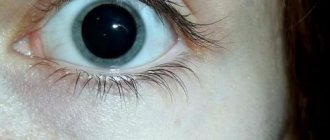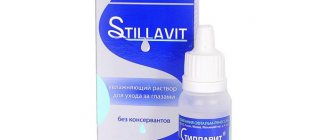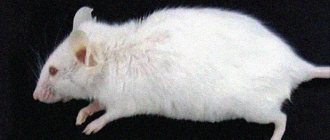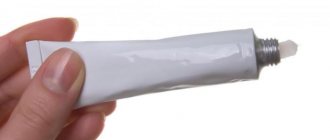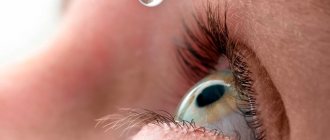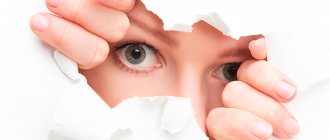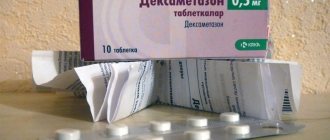With allergies, the eyes begin to water, the eyelids itch, and lacrimation increases. The whites turn red, and sometimes photophobia occurs. If negative symptoms are not stopped, local immunity quickly decreases and conjunctivitis develops. If the above symptoms appear, you should contact an ophthalmologist. You cannot purchase antiallergic eye drops on your own. They are selected based on the clinical picture, taking into account the physiological status and age of the patients.
Allergies of the organs of vision
The release of fluid is necessary to prevent dry eyes and normal functioning of the organ of vision. About 1 ml of fluid is released daily, which is evenly distributed throughout the eyeball.
However, there are some cases when the organs of vision are affected by irritants that cause allergic reactions, as a result of which the protective function of the body occurs and fluid begins to be produced twice as much.
This process leads to discomfort and disruption of the normal vision process. Increased tearing and allergic reactions can occur as symptoms of complex diseases.
Very often, when external factors that cause allergies, such as animal dander and pollen, are eliminated, tear production decreases. However, to avoid complications of the disease, it is recommended to consult a doctor who will select the right medicine and eliminate the discomfort.
Types of antiallergic eye drops
There are a large number of remedies aimed at eliminating allergic reactions. Each type of drug is used to eliminate a specific type of problem; in order to find out which drug is most suitable for reducing symptoms, you should consult a specialist.
Antiallergic eye drops are divided into the following types:
- Vasoconstrictors;
- Antihistamines;
- Anti-inflammatory.
Let's take a closer look at these types of eye drops.
Vasoconstrictors
Medicines that have a vasoconstrictor effect quickly and effectively eliminate discomfort. The principle of action is to narrow blood vessels.
Used for acute manifestations of an allergic reaction. Such medications reduce swelling of the visual organs and eliminate redness. Proper use of the drug helps eliminate the effects of allergies, which most often manifest themselves in the form of itching and burning.
However, this type of drug has some side effects, which manifest themselves as addiction to the body and reduce the effectiveness of using medicinal drops.
Antihistamines
These types of drops are used most often during seasonal exacerbations. Especially during flowering vegetation, when pollen is the cause of discomfort for many people. The action of the drops is aimed at quickly eliminating the problem and symptoms.
Eye drops reduce the risk of further spread of allergic manifestations and are suitable for frequent use.
The drops have an advantage that distinguishes them from other groups of similar drugs; it is the almost complete absence of side effects.
Anti-inflammatory
When the mucous membrane of the eye is exposed to allergens, inflammation often occurs, which reduces the level of vision and causes a large number of unpleasant sensations. This type of problem most often appears during flowering plants.
The principle of action of the drops is to quickly eliminate the source of inflammation and reduce symptoms, which most often manifest themselves as burning and redness of the eyes.
The use of such drugs is not recommended for a long time, as an overdose and lack of effect from drug treatment may occur.
Anti-inflammatory drops for allergic manifestations are divided into two types: non-steroidal and corticosteroids.
Non-steroidal
Drops to reduce allergic factors that cause inflammation in the organs of vision. They are used when symptoms of burning and itching appear, and also reduce the process of increased tearing. Suitable for frequent use and no side effects.
Corticosteroids
Medicinal substances are aimed at quickly eliminating allergy symptoms and are recommended for use only in the presence of acute allergic reactions. The active enzymes penetrate the layers of the visual organs, reduce inflammation and eliminate swelling of the eyelids.
These types of drops have the ability to destroy various types of infections and are used for various types of diseases of the organs of vision.
All eye drops that reduce allergic manifestations may manifest themselves in the form of individual side factors, so before use you should read the instructions and consult a specialist.
The best medicines
The selection of funds from the described category should be carried out exclusively by a specialist. Some people are best suited to first-generation medications due to the sedative effect required; other people do not need this effect at all. Similarly, doctors recommend the release form depending on the existing symptoms. Systemic drugs are prescribed for severe manifestations of the disease; in other situations, local remedies can be used.
How antihistamine eye drops work
When using antihistamine drops, the factors that trigger allergic reactions are eliminated.
The components of the medicinal substance are aimed at penetrating into the layers of the organs of vision.
They also block the release of histamine, which actively interacts with the appearance of allergens.
As a result, itching and redness are eliminated, and the risk of swelling of the eyelids and an increase in the level of fluid secreted by the organs of vision are reduced.
Regular use reduces the further development of allergic reactions and develops a kind of barrier that prevents re-exposure to allergens.
What is allergic rhinitis?
Allergic rhinitis is only an external manifestation of an allergy. His treatment is carried out comprehensively according to the following scheme:
- Limit exposure to the allergen (do not pet cats, do not go to the field, do not use household chemicals, etc.).
- Remove from the house all things that accumulate dust (blankets, curtains), carry out wet cleaning daily, and refuse wool clothing.
- Drug treatment, including taking nasal drops for allergies, antiallergic drugs (tablets, ointments), as well as sorbents (tablets that absorb allergens from the blood and intestines).
- Restoring weakened immunity.
- Prevention of disease.
Kromohexal nasal drops
List of the most popular eye drops for allergies
Experts very often prescribe special drops that eliminate all symptoms of allergic manifestations.
These drugs are most often used for the following diseases:
- Allergic type dermatitis , which appears as a result of exposure to chemical allergens;
- Allergic conjunctivitis is a disease that manifests itself during the period of abundant flowering of plants;
- Angioedema , which occurs as a result of eating food that causes allergic reactions.
There are a large number of medicinal substances that eliminate unpleasant symptoms from the organs of vision, however, there is a list of the most frequently prescribed by specialists, with high effectiveness in treatment.
Vasoconstrictor drops
In the presence of acute symptoms that require rapid elimination, drops are most often used, which have the property of constricting blood vessels and preventing further development of the disease. It is recommended to use such products only after a doctor’s prescription, after undergoing the necessary diagnostics.
The specialist individually prescribes a course of use depending on the type of disease and factors that cause an allergic reaction. The drug has the property of quickly penetrating into tissues and helps to partially eliminate symptoms within 10-15 minutes after use.
Vizin Alergy
Eye drops with therapeutic and antiallergic effects.
The effect of the drug is the penetration of the component levocabastine.
This component reduces the spread of discomfort and quickly copes with all symptoms.
Relief occurs 8 minutes after use.
The drug has the following indications:
- Conjunctivitis;
- Allergic reactions accompanied by increased tearfulness.
It is recommended to use the substance three to five times a day, two drops in each eye.
The course and number of drops used is determined by a specialist depending on the severity and type of problem.
The medicine has the following contraindications:
- Age up to 6 years;
- Hypertension;
- Individual sensitivity to the components of the drug;
- Damage to the cornea;
- Glaucoma.
The product is unsafe, however, in individual cases the following symptoms may occur:
- Itching;
- Redness;
- Painful sensations;
- Temporary decrease in vision.
Most often, side effects tend to disappear on their own; if the discomfort does not go away, you should consult a specialist.
The active substance must be used within 2 years from the date indicated on the package.
Store in a dry place at temperatures up to 30°C, after opening the bottle, use Visin Alergy drops for a month.
You can purchase the product at any pharmacy, the average cost is 200 rubles.
Reviews of the drug Visin Alergy:
Octilia
The effect of the drops begins immediately after use and can last up to 8 hours.
It is recommended to use this drug only after a doctor's prescription.
Since the active components have a strong effect and can cause side effects.
Apply three times a day, one drop in each eye, the course of application cannot be longer than four days.
The purpose of drops has the following types of indications:
- Inflammatory processes of the organs of vision;
- To relieve swelling;
- For side effects from using contact lenses;
- During allergic reactions.
Prescription of the drug is contraindicated for the following cases:
- Pregnancy and breastfeeding period;
- Children under 12 years of age;
- For dry eye syndrome.
Improper use of the substance can lead to discomfort, which manifests itself in the form of symptoms:
- Dizziness;
- Prolonged headache;
- Insomnia;
- Irritability.
Available without a prescription at pharmacy kiosks, the shelf life is no more than three years, provided that the storage temperature is not higher than 25 degrees. Once the bottle is opened, the shelf life is four weeks.
The average cost of drops is 250 rubles .
Reviews from experts about the drug Octilia:
Okumetil
The ophthalmic drug has a complex effect on the organs of vision, which consists of anti-inflammatory, antiseptic and antiallergic effects.
It is recommended to use drops in the following cases:
- For allergic reactions to external irritants;
- Conjunctivitis;
- Undergoing operations on the organs of vision;
- During the formation of inflammatory processes.
Before use, it is recommended to carefully read the instructions.
The use of drops is contraindicated for the following situations:
- Individual intolerance to the components of the drug;
- Lactation;
- For increased dry eyes;
- If you have glaucoma;
- For heart disease;
- Use of contact lenses.
It is recommended to use the product twice a day, a bottom drop in each eye, the duration of treatment depends on the severity of the disease, but not more than 6 days.
If used incorrectly, the following types of side effects may occur:
- Nausea;
- Drowsiness;
- Stomach upset;
- Prolonged headache;
- Dizziness;
- Weakness;
- Irritability.
The shelf life of the drops is no more than three years. At a temperature of 15-25°C, in a place protected from light.
After opening the bottle, it should be used within 1 month.
The average cost is 150 rubles .
Reviews about the drug Okumetil:
Vial
Used to quickly eliminate eye puffiness and symptoms of an allergic reaction.
The use of drops has the following types of indications:
- Allergies caused by external factors;
- Catarrhal conjunctivitis;
- Puffiness of the eyes.
The drug has a quick effect; for proper use, it is recommended to use the substance twice a day, one drop. The duration of treatment is no more than seven days.
Before using the medicinal substance, you should read the instructions in detail.
It is prohibited to use drops in the following situations:
- Children under 4 years of age;
- Pregnancy and lactation period;
- Individual intolerance to the components of the drug;
- Damage to the cornea.
When treated with drops, the following types of side effects may occur:
- Feeling of stinging in the eyes;
- Pain;
- Decreased vision;
- Redness;
- Increased blood pressure.
The drug can be purchased at any pharmacy, the average cost is 200 rubles.
Shelf life is two years on the date indicated on the package. After opening, it must be used within 28 days.
Reviews about the drug Vial:
Antihistamine eye drops
The use of such drugs tends to block receptors that are present on the surface of the organs of vision, due to which unpleasant symptoms are eliminated and reduced.
Allergodil
Eye drops have a long-lasting antiallergic effect.
It is recommended to use three times a day, 2 drops in each eye, the duration of treatment is three days.
The course of treatment can be increased on the recommendation of a doctor.
The use of drops has the following indications:
- Elimination of allergic reactions;
- Viral damage to the organs of vision;
- Conjunctivitis.
The use of drops has the following contraindications:
- Age up to 6 years;
- Pregnancy and breastfeeding period.
When using the drug in individual cases, the following symptoms of side effects may appear:
- Temporary decrease in vision;
- Stitching ptosis;
- Redness.
The average cost of drops is 350 rubles .
Shelf life is three years. After opening the bottle, the drug should be stored in the refrigerator or other cool place for no more than 6 months, with the cap tightly screwed on.
Reviews about the drug Allergodil:
Cromohexal
Cromohexal drops are used to eliminate allergic reactions, as well as for preventive purposes during seasonal exacerbations.
The active ingredients effectively reduce eye fatigue and redness after prolonged work at the computer.
It is recommended to use 2 drops, three times a day for a week; if necessary, the course of treatment can be increased.
However, it is not recommended to use the product for more than three months.
Indications for use:
- Conjunctivitis;
- Allergic reactions;
- Viral damage to the organs of vision;
- Prolonged eye strain.
It is prohibited to use:
- Age up to 5 years;
- Pregnancy and breastfeeding;
- Individual intolerance to the constituent components.
Side effects manifest themselves in the form of redness and swelling of the eyelids.
You can buy drops at any pharmacy, the average cost is 100 rubles .
The shelf life of the drug is three years. Once opened, the bottle can be stored for 6 weeks. The drug is kept in a place inaccessible to direct sunlight, at a temperature not exceeding +25.
Reviews about the drug Cromohexal:
Opatanol
Eye drops, which are very often prescribed to eliminate discomfort.
The action of the substance is aimed at rapid penetration and relieves unpleasant symptoms within 15 minutes.
The duration of the result is from 4 to 6 hours.
Contraindications:
- Age up to three years;
- Individual intolerance to components.
The use of drops can cause side effects, which are manifested by the following symptoms:
- Increased tear production;
- Decreased vision at the time of using drops;
- Swelling;
- Redness;
- Dizziness.
The eye medication is used two drops three times a day, the course of treatment is individual depending on the degree and complexity of the disease, and can last from one week to 4 months.
You should not increase the dosage of the drug yourself, otherwise this will contribute to an overdose and poor health.
You can buy drops at a pharmacy, the average cost is 400 rubles .
Shelf life 3 years. After opening the bottle, Opatanol drops can be stored for no more than 4 weeks.
Reviews about the drug Opatanol:
Ketotifen
Drops are prescribed to eliminate many diseases of the organs of vision.
Reduce allergy symptoms and eliminate inflammatory processes.
They are used after consultation with a doctor and are effective before the onset of allergic symptoms as a preventive measure.
It is recommended to use the drops twice a day, one drop in the morning and one in the evening. It is not recommended to use the course for more than two weeks.
Indications for use:
- Allergic conjunctivitis;
- Keraconjunctivitis;
- Viral eye infections;
- Seasonal allergic symptoms.
The drug is prohibited from use:
- Children under 12 years of age;
- Pregnancy and breastfeeding;
- Kidney diseases;
- Individual intolerance to the components of the drug;
- Increased dryness of eyes.
With regular use of the drug, some types of side effects may occur.
They appear in the form:
- Drowsiness;
- Fatigue;
- Apathy;
- Headache;
- Redness of the eyelids;
- Swelling;
- Burning.
Experts do not recommend reducing or increasing the dosage of the drug on your own; this may lead to a decrease in the effectiveness of treatment.
The cost of the drug is 100 rubles .
Shelf life is three years.
Reviews of the drug Ketotifen:
Olopat
The drops have an antihistamine effect, so they help reduce itching and redness.
Widely used to relieve inflammation during exacerbation of seasonal allergic manifestations.
Before use, it is recommended to consult a doctor to determine the most appropriate dosage and course of treatment.
Indications for use:
- Eye irritation after using contact lenses;
- Allergic reactions;
- Irritation of the eye membranes by external chemical factors;
- Conjunctivitis;
- Infectious eye lesions.
This type of product is prohibited for use by children under 12 years of age, as well as during pregnancy and lactation.
During treatment, some types of side effects may occur:
- Itching;
- Redness;
- Burning;
- Swelling.
Use one drop in the morning and evening, on average the duration of treatment lasts no more than two weeks.
However, you should not prescribe the duration of use of the medication yourself; the doctor determines the method of using the drops depending on the type of disease.
The cost of drops is on average 300 rubles .
The product has a shelf life of 3 years and is available in pharmacies without a prescription.
Lecrolin
Lecrolin drops are an antihistamine that has an effect on the mucous membrane of the eye, including the elimination of allergic reactions.
Thanks to active enzymes that penetrate the cells, discomfort is eliminated and a further barrier is developed that prevents re-infection.
Indication:
- Conjunctivitis;
- Allergic reactions;
- Viral eye infections;
- Keratitis;
- Inflammatory formations.
Contraindications:
- During pregnancy and breastfeeding;
- Hypersensitivity to the drug.
The drops are well tolerated by the body; in some cases, burning and redness may occur.
On average, two drops are used in each eye twice a day. The course of treatment lasts until the symptoms disappear completely.
Available in pharmacies without a prescription, shelf life is three years. After opening the bottle or dropper tube, the shelf life is 1 month.
The average cost is 100 rubles .
Reviews about the drug Lecrolin:
Azelastine
Effective drops, which are prescribed to restore the mucous membrane of the eyes, have anti-inflammatory and antiallergic properties.
It is used both for preventive measures and to eliminate symptoms of the development of the problem.
Contraindications:
- During pregnancy and breastfeeding;
- Children under 4 years of age;
- Individual intolerance to components.
The use of medicinal drops can cause the following types of side effects:
- Skin rash;
- Cough;
- Redness of the eyes;
- Swelling;
- Headache.
One drop is prescribed four times a day until the unpleasant symptoms disappear.
When used to treat children, the course of treatment is prescribed individually by a doctor.
Dispensed without prescription at the pharmacy, shelf life 2 years. After opening, store for 1 month.
The cost of the medicine is 450 rubles .
Anti-inflammatory
The drops have active enzymes that help eliminate the inflammatory process and reduce swelling.
Acular
Non-steroidal drops aimed at obtaining quick and long-term relief of discomfort.
Prescribed for various damage to the mucous membrane of the eyes and allergic symptoms.
Contraindications:
- Pregnancy;
- Individual intolerance;
- Age 12 years;
- Kidney diseases.
The drops are well absorbed by the body and do not cause side effects; in individual cases, redness of the eyelids may occur.
Use one drop four times a day, the course of treatment is no more than four days.
The shelf life of the drops is two years. After opening the dropper bottle, it should be used no more than 28 days before.
The average cost is 180 rubles .
Dexamethasone
Drops are a type of hormonal drug, and are most often prescribed for complex diseases.
The active components of the drug quickly penetrate the mucous membrane and eliminate discomfort.
Indications:
- Damage to the cornea;
- Inflammatory processes after eye surgery;
- Severe allergy symptoms.
Contraindications:
- Viral damage to the cornea;
- Pregnancy;
- Childhood;
- Individual intolerance to components.
Eye drops are used three times a day, 2 drops, the course of treatment depends on the type of disease, but no more than three weeks.
The shelf life of the drug is two years from the date indicated on the package. The opened bottle should be tightly screwed each time and stored in the refrigerator for no more than 1 month.
The average cost is 60 rubles .
Reviews about the drug Dexamethasone:
Levomycetin
Drops are prescribed for various types of infections of the organs of vision, as well as to eliminate various factors causing unpleasant symptoms.
The components are quickly absorbed into the mucous membrane and begin to act after 30 minutes.
Indications:
- Conjunctivitis;
- Keratitis;
- Inflammatory processes of the eyelids;
- Allergic reactions.
The drug is prescribed one drop three times a day for a week; if necessary, the course of treatment can be increased as prescribed by the doctor.
Contraindications:
- Age up to 5 years;
- Pregnancy;
- Kidney failure.
The use of drops can cause the following types of side effects:
- Redness;
- Burning;
- Dizziness;
- Nausea.
Drops are available at pharmacies without a prescription. Shelf life: 2 years, stored in the refrigerator at 25 degrees. After opening the dropper bottle, the drug can be used for 30 days.
The average cost is 4 0 rubles .
Reviews about the drug Levomycetin:
Diclofenac
Diclofenac eye drops have an analgesic and anti-inflammatory effect, the active components quickly relieve swelling and reduce excessive tearing.
They are used to quickly eliminate unpleasant symptoms and can be used without a doctor’s prescription.
The medicine is used one drop four times a day. The course of treatment lasts from one to two weeks.
The use of Diclofenac eye drops may cause the following types of side effects:
- Burning;
- Cloudiness of the cornea;
- Pain in the eyes.
Before use, it is recommended to read the instructions; it is prohibited to use the substance of the following category:
- Individual intolerance;
- Children under 5 years old;
- During pregnancy and breastfeeding;
- Bronchial asthma.
The shelf life of the drug is 2 years if the temperature is maintained at no higher than 15 degrees. After opening the bottle, it can be stored for no more than four weeks.
The average cost is 30 rubles .
Reviews of the drug Diclofenac:
Maxidex
Corticosteroids are recommended to relieve acute allergy symptoms.
Drops are prescribed in the following situations:
- Allergic blepharitis;
- Allergic conjunctivitis;
- Allergic keratoconjunctivitis;
- Acute and chronic iritis;
- Iridocyclitis;
- Prevention and treatment of inflammatory reactions in the postoperative period;
- Thermal and chemical burns.
Contraindications for use:
- Intolerance to any component of the drug;
- Treatment of ophthalmological diseases of fungal, mycobacterial and viral etiology;
- For inflammatory pathologies complicated by a purulent process, immunosuppression, increased intraocular pressure;
- Childhood.
It is recommended to use 1-2 drops every 3-6 hours, depending on the nature of the disease, the course of treatment is 2-3 weeks.
With long-term use of the drug, the following may occur:
- Increased intraocular pressure (therefore, when used for more than 10 days, intraocular pressure should be measured regularly);
- Formation of posterior subcapsular cataract;
- Slowing down the wound healing process.
Dispensed in a pharmacy without a prescription, expiration date is 3 years from the date indicated on the package. Use within 4 weeks after opening the bottle.
The average cost is 300 rubles .
Reviews about the drug Maxidex:
Lotoprednol
Eye drops are prescribed for allergic reactions and quickly relieve itching and redness. Widely used to relieve swelling and inflammation caused by infection of the mucous membrane of the organs of vision.
Lotoprednol is a hormonal drug and requires an individual course of treatment.
Apply one drop twice a day, the course of treatment is no more than seven days. Before use, you should consult a specialist.
Contraindications:
- Age up to 7 years;
- Pregnancy period;
- Kidney failure;
- Increased dryness of the organs of vision.
The drug is well tolerated by the body; in individual cases, redness and burning in the eye area may be observed.
Drops can be purchased at any pharmacy kiosk.
The average price of drops is 160 rubles .
How often can I take it?
Most manufacturers of the described products produce such medications in a convenient dosage, which involves use once a day. The question of how to use antihistamines, depending on the regularity of the occurrence of negative clinical manifestations, is decided with the doctor. This category of medications is classified as symptomatic treatment methods. They must be used whenever signs of the disease occur each time.
New antihistamines can be used as prophylaxis. If contact with the allergen cannot be avoided (we are talking about poplar fluff, ragweed flowering, etc.), you should use the medicine in advance. Preliminary use of antihistamines will not just soften negative symptoms, but eliminate their occurrence. H1 will be completely blocked by this point, when the immune system begins to launch a protective reaction.
We reviewed antihistamines in drops for children and adults.
Anti-allergy eye drops for children
If allergies appear in childhood, you should not use eye drops on your own. You should visit a doctor who will prescribe the most appropriate substance for the child’s age and the severity of the existing problem.
The most commonly prescribed types of drugs are:
- Kromoglin - use is allowed from the 1st month, average price 130 rubles ;
- Hi-Krom - use is allowed from the 1st year, average price 80 rubles ;
- Kromosol - allowed for use from 2 years old, average price 100 rubles ;
- Cromohexal - allowed for use from 2 years of age, average price 110 rubles ;
- Opatanol - allowed for use from 3 years old, average price 400 rubles ;
- Lecrolin - allowed for use from 4 years old, average price 100 rubles ;
Allergy eye drops for children under 3 years of age must be prescribed by a specialist.
When using the drug, you must carefully monitor the body's reaction and stop using it in case of side effects.
"Tizin alert"
It is a new generation product made in Israel, based on levocabastine.
The active substance is a blocker of H1-histamine receptors. It suppresses the production of histamine and other allergy mediators, reducing the sensitivity of body cells to them.
Quickly relieves allergic rhinitis - discharge, itching, congestion, sneezing. Do not use in children under 6 years of age.
Basic rules for instillation
Before using eye drops, it is recommended to observe the following rules:
- Before instillation, you need to prepare drops and a cotton swab;
- Wash your hands thoroughly with antibacterial soap;
- In a sitting position, you need to tilt your head back and, pulling your eyelid with your hand, drip the required amount of substance;
- Close your eyes and remove excess liquid with a cotton swab;
- Remain in this position for several seconds;
- Carefully close the package containing the medicine.
When using drops, do not touch the tip of the bottle to the mucous membrane of the eye.
Eye drops for allergies during pregnancy and breastfeeding
The use of eye drops during pregnancy and breastfeeding is prohibited.
Since the active ingredients can be absorbed and negatively affect the health of the fetus, as well as transmitted through breast milk.
In individual cases, pregnant women may be prescribed the following medications for allergies: Lecrolin and Ketafen .
The course of treatment with such medications is prescribed for each patient individually.
Review
In this dosage form, local and at the same time systemic drugs are produced. Antihistamine drops intended for oral administration include “Zirtec” along with “Dezal”, “Fenistil”, “Zodak”, “Xizal”, “Parlazin”, “Zaditor”, “Allergonix” and other analogues.
Antihistamine topical nasal drops include products in the form of “Tizin Allergy”, “Allergodil”, “Lecrolina”, “Cromohexal”, “Sanorin Analergin”, “Vibrocil” and others.
Antiallergic eye drops include “Opatanol” along with “Zaditen”, “Allergodil”, “Lecrolin”, “Nafkon-A”, “Cromohexal”, “Vizin”, “Okumethyl” and other synonyms.
